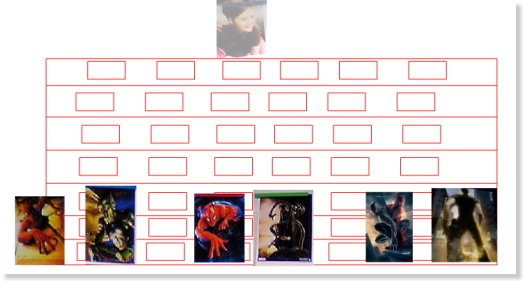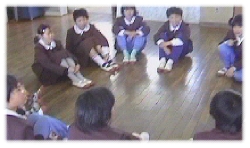Once upon a time, an old woman and her husband lived alone in a little old house. The couple had no children, and being lonely, the woman decided to make a boy of gingerbread. She carefully mixed the batter, rolled out the dough, and cut out out a very nice gingerbread man. She added sugar icing for his hair, mouth, and clothes, and she used candy chips for buttons and eyes. What a fine looking gingerbread man he was! The old woman put him in the oven to bake. After he was fully done, she slowly opened the oven door. Up jumped the gingerbread man, and he ran out the door saying,
"Run, run, as fast as you can!
You can't catch me!
I'm the Gingerbread Man!"
The old woman and the old man ran after him, but they could not catch him.
 And so the Gingerbread Man ran and ran. While he running, he met a cow.
And so the Gingerbread Man ran and ran. While he running, he met a cow."Moo," said the cow. "You look very fine! Fine enough to eat!" And the cow started to chase to little man.
But the Gingerbread Man ran faster, saying,
"I ran away from an old woman,
I ran away from an old man,
And I can run away from you!
I can!"
And he laughed,
"Run, run, as fast as you can!
You can't catch me!
I'm the Gingerbread Man!"
The cow ran after the Gingerbread Man, but she could not catch him.
 The Gingerbread Man kept running, and soon he met a horse.
The Gingerbread Man kept running, and soon he met a horse."Neigh," said the horse, "You look mighty tasty. I think that I would like to eat you."
"But you can't!" said the Gingerbread Man.
"I ran away from an old woman,
I ran away from an old man,
I ran away from a cow,
And I can run away from you!
I can!"
And so he ran singing,
"Run, run, as fast as you can!
You can't catch me!
I'm the Gingerbread Man!"
The horse ran after the Gingerbread Man, but he could not catch him.
 The Gingerbread Man ran and ran, laughing and singing. While he ran, he met a chicken.
The Gingerbread Man ran and ran, laughing and singing. While he ran, he met a chicken."Cackle, cackle," said the chicken, "You look fine enough to peck for dinner. I'm going to eat you, Mr. Gingerbread Man."
But the Gingerbread Man just laughed.
"I ran away from an old woman,
I ran away from an old man,
I ran away from a cow,
I ran away from a horse,
And I can run away from you!
I can!"
And so he ran singing,
"Run, run, as fast as you can!
You can't catch me!
I'm the Gingerbread Man!"
The chicken ran after the Gingerbread Man, but she could not catch him.
The Gingerbread Man was proud that he could run so fast.
"Nobody can catch me," he thought. So he kept on running until he met a fox.
He just had to tell the fox how he ran faster than all the others.
 "Mr. Fox," he said,
"Mr. Fox," he said, "As tasty as I appear to be,
I cannot let you catch and eat me.
I ran away from an old woman,
I ran away from an old man,
I ran away from a cow,
I ran away from a horse,
I ran away from a chicken,
And I can run away from you!
I can!"
But Mr. Fox did not seem to care.
"Why would I want to bother you?" asked Mr. Fox. "You don't even look that tasty. No, young man, I don't want to eat you at all."
The Gingerbread Man was so relieved.
"Well, indeed, Mr. Fox," said the Gingerbread Man. "If you don't mind, I think I'll take a little rest here." And the Gingerbread Man stopped running and stood still.
And right when he stood still. Snap! went Mr. Fox's jaws right into the Gingerbread Man until he was gone.
"He was very tasty after all," thought the fox.





 Stopwatch!
Stopwatch!


 "Mr. Fox," he said,
"Mr. Fox," he said,